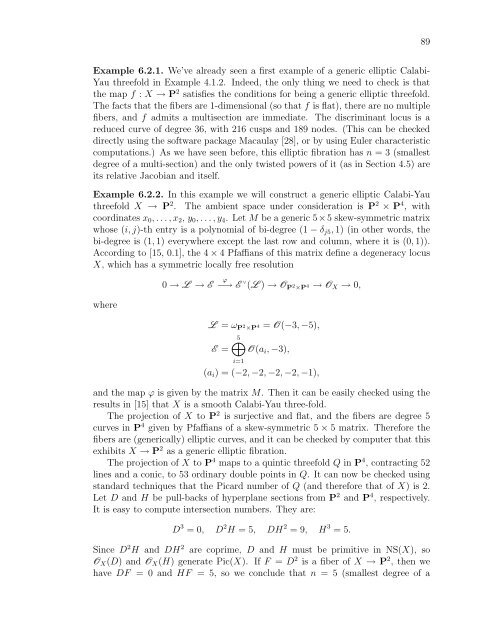derived categories of twisted sheaves on calabi-yau manifolds
derived categories of twisted sheaves on calabi-yau manifolds
derived categories of twisted sheaves on calabi-yau manifolds
You also want an ePaper? Increase the reach of your titles
YUMPU automatically turns print PDFs into web optimized ePapers that Google loves.
Example 6.2.1. We’ve already seen a first example <str<strong>on</strong>g>of</str<strong>on</strong>g> a generic elliptic Calabi-<br />
Yau threefold in Example 4.1.2. Indeed, the <strong>on</strong>ly thing we need to check is that<br />
the map f : X → P 2 satisfies the c<strong>on</strong>diti<strong>on</strong>s for being a generic elliptic threefold.<br />
The facts that the fibers are 1-dimensi<strong>on</strong>al (so that f is flat), there are no multiple<br />
fibers, and f admits a multisecti<strong>on</strong> are immediate. The discriminant locus is a<br />
reduced curve <str<strong>on</strong>g>of</str<strong>on</strong>g> degree 36, with 216 cusps and 189 nodes. (This can be checked<br />
directly using the s<str<strong>on</strong>g>of</str<strong>on</strong>g>tware package Macaulay [28], or by using Euler characteristic<br />
computati<strong>on</strong>s.) As we have seen before, this elliptic fibrati<strong>on</strong> has n = 3 (smallest<br />
degree <str<strong>on</strong>g>of</str<strong>on</strong>g> a multi-secti<strong>on</strong>) and the <strong>on</strong>ly <str<strong>on</strong>g>twisted</str<strong>on</strong>g> powers <str<strong>on</strong>g>of</str<strong>on</strong>g> it (as in Secti<strong>on</strong> 4.5) are<br />
its relative Jacobian and itself.<br />
Example 6.2.2. In this example we will c<strong>on</strong>struct a generic elliptic Calabi-Yau<br />
threefold X → P 2 . The ambient space under c<strong>on</strong>siderati<strong>on</strong> is P 2 × P 4 , with<br />
coordinates x0, . . . , x2, y0, . . . , y4. Let M be a generic 5×5 skew-symmetric matrix<br />
whose (i, j)-th entry is a polynomial <str<strong>on</strong>g>of</str<strong>on</strong>g> bi-degree (1 − δj5, 1) (in other words, the<br />
bi-degree is (1, 1) everywhere except the last row and column, where it is (0, 1)).<br />
According to [15, 0.1], the 4 × 4 Pfaffians <str<strong>on</strong>g>of</str<strong>on</strong>g> this matrix define a degeneracy locus<br />
X, which has a symmetric locally free resoluti<strong>on</strong><br />
where<br />
0 → L → E ϕ<br />
−→ E ∨ (L ) → O P 2 ×P 4 → OX → 0,<br />
L = ωP2 ×P4 = O(−3, −5),<br />
5<br />
E = O(ai, −3),<br />
i=1<br />
(ai) = (−2, −2, −2, −2, −1),<br />
and the map ϕ is given by the matrix M. Then it can be easily checked using the<br />
results in [15] that X is a smooth Calabi-Yau three-fold.<br />
The projecti<strong>on</strong> <str<strong>on</strong>g>of</str<strong>on</strong>g> X to P 2 is surjective and flat, and the fibers are degree 5<br />
curves in P 4 given by Pfaffians <str<strong>on</strong>g>of</str<strong>on</strong>g> a skew-symmetric 5 × 5 matrix. Therefore the<br />
fibers are (generically) elliptic curves, and it can be checked by computer that this<br />
exhibits X → P 2 as a generic elliptic fibrati<strong>on</strong>.<br />
The projecti<strong>on</strong> <str<strong>on</strong>g>of</str<strong>on</strong>g> X to P 4 maps to a quintic threefold Q in P 4 , c<strong>on</strong>tracting 52<br />
lines and a c<strong>on</strong>ic, to 53 ordinary double points in Q. It can now be checked using<br />
standard techniques that the Picard number <str<strong>on</strong>g>of</str<strong>on</strong>g> Q (and therefore that <str<strong>on</strong>g>of</str<strong>on</strong>g> X) is 2.<br />
Let D and H be pull-backs <str<strong>on</strong>g>of</str<strong>on</strong>g> hyperplane secti<strong>on</strong>s from P 2 and P 4 , respectively.<br />
It is easy to compute intersecti<strong>on</strong> numbers. They are:<br />
D 3 = 0, D 2 H = 5, DH 2 = 9, H 3 = 5.<br />
Since D 2 H and DH 2 are coprime, D and H must be primitive in NS(X), so<br />
OX(D) and OX(H) generate Pic(X). If F = D 2 is a fiber <str<strong>on</strong>g>of</str<strong>on</strong>g> X → P 2 , then we<br />
have DF = 0 and HF = 5, so we c<strong>on</strong>clude that n = 5 (smallest degree <str<strong>on</strong>g>of</str<strong>on</strong>g> a<br />
89
















